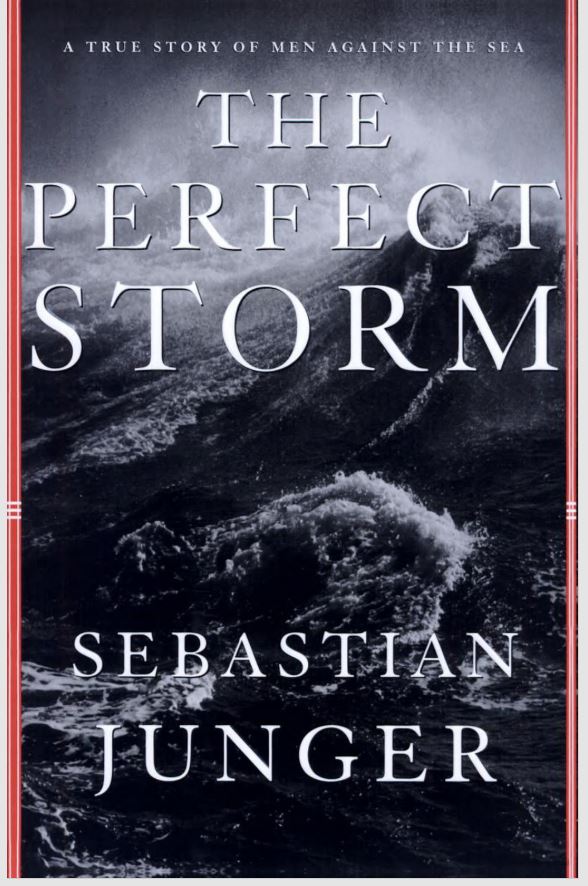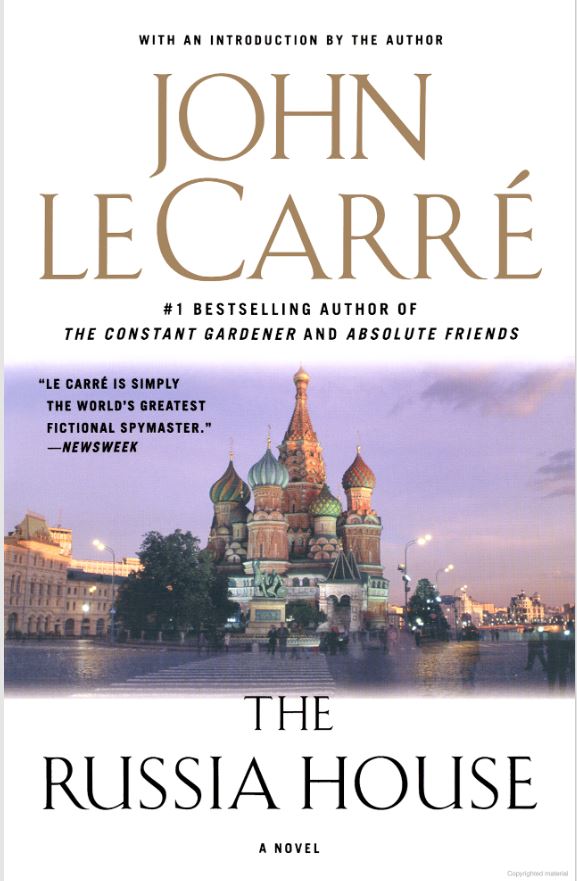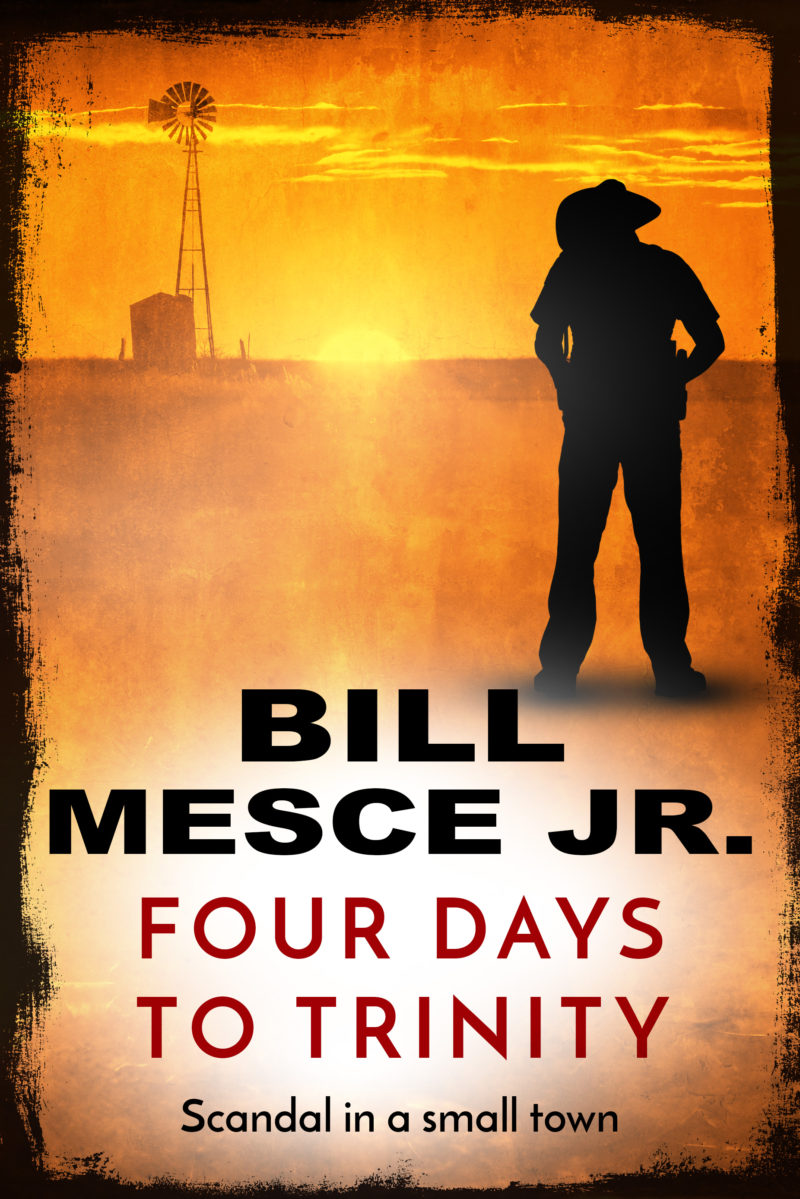Photo by Rob Potter on Unsplash
***
The Magician’s Trick:
Telling, Not Showing
by Bill Mesce, Jr.
Possibly one of the most cited maxims in writing is, “Show, don’t tell.” And like most writing maxims, this is worthwhile more-often-than-not advice, but lousy law-making. Some prose efforts work precisely because they don’t show. Let’s look at two respected works: Sebastian Junger’s 1991 nonfiction The Perfect Storm, and the 1989 novel The Russia House, from master of spy fiction John LeCarre.
 One way to understand the unconventional structure of Junger’s book is to picture a massive, wall-sized mosaic, an epic display of some historical saga, and there in the middle of the mosaic is a gap. From the tiles around that space, we have a fair impression of what the missing tile probably looks like. But, as you stare at the empty hole, what haunts you is knowing that you don’t know, not for sure. It’s that mystery quality which gives the missing tile a black hole kind of weight, holding your attention in a way the filled-in rest of the mosaic can’t.
One way to understand the unconventional structure of Junger’s book is to picture a massive, wall-sized mosaic, an epic display of some historical saga, and there in the middle of the mosaic is a gap. From the tiles around that space, we have a fair impression of what the missing tile probably looks like. But, as you stare at the empty hole, what haunts you is knowing that you don’t know, not for sure. It’s that mystery quality which gives the missing tile a black hole kind of weight, holding your attention in a way the filled-in rest of the mosaic can’t.
The “hook” of Junger’s book is the 1991 loss of the commercial “sword boat” (a fishing boat dedicated to catching swordfish) Andrea Gail during a massive storm in the North Atlantic (actually, a combination of weather systems creating the titular “perfect storm”). The challenge for Junger was that, beyond her loss, no one knows what happened to the Andrea Gail. There were no survivors, no witnesses. Junger had access to people who knew the crew, who knew the vessel, but little is known of what transpired aboard her once she left her dock in Gloucester one morning in September. Junger understands the dilemma – how do you tell the story of an event no one witnessed? – as well as the temptations to cheat around it, and confronts them head-on in his Foreword:
“I wanted to write a completely factual book…I toyed with the idea of fictionalizing minor parts of the story – conversations, personal thoughts, day-to-day routines – to make it more readable, but that risked diminishing the value of whatever facts I was able to determine.”
Junger’s solution:
“I would interview people who had been through similar situations, and survived. Their experiences…would provide a fairly good description of what the six men on the Andrea Gail had gone through, and said, and perhaps even felt.”
Actually, Junger goes one better, regularly pulling back from the story of the lost fishing boat to place it against the larger canvas of the history of the Gloucester fishing industry, and, in that, find the still larger, universal, eternal theme of Man vs. Nature.
Unable to tell the linear tale of the Andrea Gail and her crew in any complete, factual way, Junger tells what he does know, and uses it recurrently as a springboard to those larger, non-linear, Big Picture perspectives; the other tiles in the mosaic. For example:
His opening twenty-odd pages see the crew considering one, last, fall run into the North Atlantic. Junger’s narrative continually eases out of the book’s present to place this routine action in context. By page 15, we know how expensive a sword boat’s one- to two-month run can be making it a high-stakes game for the crew (on page 14, Junger breaks down the Andrea Gail’s previous $140,000 haul which, less expenses and the owner’s share, leaves the six-man crew less than $45,000 to split in unequal shares depending on seniority). We’ve also, in that same short span, come to understand that the risks are not all financial: “One ill-kept piece of gear can kill a man. Charlie Reed saw a hoisting block fall on someone and shear his arm right off…”. By page 19, Junger has been able to place his story in the same historical continuum as Melville’s Moby Dick; the sword boat’s crew in the same ancestral lineage as Melville’s Ishmael and Queequeg; and their favorite hangout – a saloon called The Crow’s Nest – as a direct ancestor to the Spouter Inn where Ishmael and Queequeg become sailing brothers.
These injections of rarely more than a paragraph or two are never long enough to slow the forward momentum of the book, but let us know that, rather than looking at a stand-alone occurrence, we are seeing only the latest chapter in a long-standing, ongoing battle between those men whose livelihood is on the water, and a brutal, unpredictable, and unforgiving sea.
At times, the book takes a more ruminative tone, stepping back still further for a more in-depth appraisal of that larger picture. At page 25, Junger stands back for a seven-page reflection on the history of the Gloucester fishing trade, going back as far as the 1650s and bringing it up to the present, always marked by two perennial constants: the possibility of big paydays, and the potential for tragedy. These extended “step-backs” go even further toward placing the Andrea Gail’s last voyage not as a singular disaster, but as a representative example of the risks and losses that are, and have always been, part and parcel to deep sea fishing.
This becomes the pattern of the book: a bit of narrative of what little is known of the doomed sword boat’s last run, and then stepping outside that line for a bit of history, or the experiences of other sword boat crews:
“Back in 1983, a friend of (sword boat captain Albert) Johnston ran into a fall gale…The seas were so big that Johnston’s friend had to goose the throttle just to keep from sliding backward down their faces. The boat was forced sixty miles backward – despite driving full-steam ahead – because the whole surface of the ocean had been set in motion. At one point the captain glanced out the window and saw an enormous wave coming at him…the wave bore down on them, slate-colored and foaming, and blew the wheelhouse windows out.”
In common with books like Siegfried Krakauer’s Into Thin Air (climbing Mt. Everest), or, a personal favorite of mine, Ernest K. Gann’s Fate Is the Hunter (risky early days of commercial flying), or, for that matter, Gordon Lightfoot’s musical telling of another modern-day shipping disaster, “The Wreck of the Edmund Fitzgerald,” these historical and contemporary asides bring home the underlying theme that even skilled professionals operating at the top of their game can’t outplay brute nature and bad luck. You can do everything right and still not come home.
(The creative failure of the 2000 film adaptation of The Perfect Storm can be directly attributed to the filmmakers trying to shape Junger’s non-linear mosaic into a more conventionally structured adventure tale. The filmmakers indulge in all the cheats Junger studiously avoids by making up what they don’t know which, going by Junger’s book, is almost everything about the boat’s last run. While the point of Junger’s book was the prosaic melancholy of the it’s-happened-before-it’ll-happen-again nature of the Andrea Gail’s loss, the film takes the disasters related by various sword boat captains in the book and piles them in Greatest Hits fashion on the movie’s sword boat crew so that her last voyage takes on an inflated, artificially epic quality, completely contrary to the tone of Junger’s book.)
Junger’s scope widens throughout the narrative, particularly as the storm’s menace broadens and intensifies, eventually encompassing other vessels caught in the storm, as well as the Coast Guard rescue teams which aided some of them, thereby giving us an up-close view of the same violent conditions through which the Andrea Gail was steaming. He also provides such disturbing sidebars as a detailed two-and-a-half page, step-by-step description of the human body’s response to drowning:
“The central nervous system does not know what has happened to the body; all it knows is that not enough oxygen is getting to the brain. Orders are still being issued – Breathe! Pump! Circulate! – that the body cannot obey.”
By the end of Junger’s account, we may not know for sure what transpired on the Andrea Gail, but he’s given us enough information for us to sense the likelihoods. In the daily routines on other sword boats, we know how the Andrea Gail’s crew probably spent their days. In the tragedies which other vessels weathered and to which, in some cases, they succumbed, we know the possibilities which could have taken the sword boat under. And, in a passage like the one above, we know what the last moments of the crew were probably like. The strategy we learn from Junger is how to tell a story we can’t know by telling the myriad, reflective stories around it that we do know.
Like the New England whalers’ wives who stood on their widow’s walks a century and a half ago, looking out at the empty Atlantic waiting for ships that never returned, we both know the story of the Andrea Gail… and we don’t. That’s what hooks us into peering into that empty space in the mosaic and keeps us wondering.
*****
Junger was limited by circumstance to what he could “show” about a true story. John LeCarre, on the other hand, works in fiction; he has a choice. And in The Russia House, he deliberately chooses not to show, and it is this very defiance of the conventional wisdom of narrative storytelling that makes The Russia House one of his best works.
 A good magician, particularly one who works close to an audience, must be a master of the art of misdirection. The magician draws your attention to the entrancing dance performed by his left hand – “See? Nothing in my hand!” — while his ignored right one executes a deft sleight-of hand – “Presto!” – pulling a quarter from behind your ear; an illusion we like to think of as magic. LeCarre does something similar in The Russia House, having us look one way while he pulls off something unexpected in another direction. LeCarre misdirects us by often doing nothing but telling instead of showing, tilting our attention in a certain direction, our view of the novel’s events funneled through the perceptions of a jaded, tunnel-visioned narrator, while out there in the area of the unshown, the author is pulling off his magic trick.
A good magician, particularly one who works close to an audience, must be a master of the art of misdirection. The magician draws your attention to the entrancing dance performed by his left hand – “See? Nothing in my hand!” — while his ignored right one executes a deft sleight-of hand – “Presto!” – pulling a quarter from behind your ear; an illusion we like to think of as magic. LeCarre does something similar in The Russia House, having us look one way while he pulls off something unexpected in another direction. LeCarre misdirects us by often doing nothing but telling instead of showing, tilting our attention in a certain direction, our view of the novel’s events funneled through the perceptions of a jaded, tunnel-visioned narrator, while out there in the area of the unshown, the author is pulling off his magic trick.
The framework for all this prestidigitation is a rather familiar espionage story. Barley Blair, a burned-out, alcoholic, minor publisher is impressed by British intelligence into acting as a contact for the Russian Katya, herself a go-between for Yakov, a disaffected Russian who wants to pass a manuscript revealing Soviet military secrets to Blair whom he’d once met at a booze-fueled party. LeCarre himself had used vaguely similar plots featuring civilians coaxed or manipulated into intelligence work in his earlier novels The Looking Glass War (1965) and Little Drummer Girl (1983). It is that very familiarity LeCarre uses to hold our attention, playing to our expectations of how a story like this is supposed to play out.
LeCarre pulls off his distraction with an approach not too unlike Fitzgerald’s The Great Gatsby. Like Gatsby, Blair is the central character in his story…but not the main character. Again, as in Fitzgerald’s novel, that role falls to Russia’s first person narrator, Harry dePalfrey, an intelligence veteran and the legal counsel on the team “running” Blair. Not only are we restricted to what dePalfrey sees and hears, but it comes to us through the skewed perspective of someone who has spent too long immersed in a world where deception and deceit are the air and water of the spying life. DePalfrey can’t always see things for what they are, but only for what he’s been conditioned to expect them to be.
LeCarre keeps Blair “off-stage” for an impressively long time. He is absent from his booth when Katya first attempts to contact him at a trade show during the story’s opening, and thereafter, British intelligence spends a good deal of time trying to find him. Fifty-seven pages into the 431-page novel, dePalfrey tells us “…it is a matter of Service history that the week-long manhunt for…Barley Scott Blair generated enough frenzy and frustration to power a dozen secret networks…After five days of chasing after him, they thought they knew everything about Barley except where he was.” It’s still another few pages before Blair makes his first, unimpressive appearance: “Barley was sitting at the bar when Merridew walked in on him. He was perched on a stool and shooting his mouth off about human nature to a drink-sodden expatriate major of artillery…”.
Even though Blair is the emotional keystone of the narrative, subsequently, in terms of physical presence, he qualifies as only a supporting character being absent from the novel for significant periods of time. For instance, from p. 210-231, dePalfrey’s narrative drops away from Blair completely to focus on his own dealings with his organization’s pushy, over-funded American counterparts. It is only belatedly we come to realize that this is Blair’s story; something even the other characters, including dePalfrey, fail to realize until too late.
To know how to manage Blair, his handlers investigate him in depth, and most of what the reader comes to know of Blair is what those handlers have amassed as digested by dePalfrey:
“I thought about his file. So many headlong crashes, acts of seeming self-destruction, so little prudence. His frightful school record. His efforts to earn himself a few laurels by boxing, for which he ended up in the school sanatorium with a broken jaw. His expulsion for being drunk while reading the Epistle at Sung Eucharist…Ned had shown me his entire life, secret annexes and all, medical history, money, women, wives, children. And it was small stuff all the way. No big bang, no big crime. No big anything – which may have been the explanation of him.”
LeCarre keeps Blair at a still further remove by giving dePalfrey a rather full agenda of his own. Setbacks both personal and professional pushed dePalfrey into the insular intelligence community, his marriage is dead, his affair with a married woman dying, and he’s constantly busy with another of LeCarre’s favorite tropes, the petty bureaucracy and frustrating politics (including the jockeying with the Americans) that are as much a part of the spy business as they are of any corporate enterprise (it’s an insider’s rendering; LeCarre himself had worked for British intelligence services in the late 1950s-early 1960s).
All of these tactics – the first person narrator occupying center stage, the narrator’s own busy plotline, Blair’s only intermittent appearances – give Blair the appearance of being just one cog in a large mechanism.
LeCarre kind of/sort of cheats at one point, finally connecting us to Blair directly. From pages 157-159, LeCarre segues from dePalfrey’s narrative to a third person POV focused on Blair and his reaction to meeting Katya, and then on 168, the POV shifts again, this time to Katya. For the next thirty-odd pages, the POV rests primarily with Blair and, to a lesser degree, Katya. Although those characters won’t get that kind of attention again, it’s enough for the reader to see something sparking between the two that their masters (British intelligence and Yakov respectively) don’t have the eyes to see.
Blair’s handlers aren’t completely blind to it; it just doesn’t register. After Blair’s first series of meetings with Katya, he’s flown to an isolated island off the English coast where his American and British handlers interrogate him at length on the most minute aspects of his dealings with Katya and Yakov as they try to determine the motives and credibility of the Russians. In the process, at least one of Blair’s handlers tips to what’s going on between Blair and Katya. Yet…
“Did Barley lie to you?”
(This from dePalfrey) “Not unduly.”
“He’s straight. It’s a straight case. Do you remember straight? While you’re thinking round corners, (Yakov’s) going straight for the goal. And he’s chosen Barley as his running mate. Barley’s the only chance we have.”
“He’s in love with the girl,” said Brady. “He’s complicated. He’s a liability.”
(DePalfrey again) “He’s in love with hundreds of girls. He proposes to every girl he meets. That’s who he is. It’s not Barley who thinks too much. It’s your people.”
And that, in the end, is the problem for dePalfrey and the rest of his colleagues: they can’t remember “straight,” and LeCarre has us so plugged into their mindset, that we forget it as well.
Eventually, Blair is sent back to Russia with a “shopping list” of questions meant to determine Yakov’s authenticity. But while in Russia, Blair disappears. As his handlers piece it together, the KGB has used Yakov to bait out the British, and this, in turn, has put Katya in danger. Blair has traded the shopping list (itself of value as its concerns suggest British capabilities) for KGB assurances that Katya and her family will be left alone. A year or so later, Blair surfaces in Portugal (in this section he tells his side of the story to dePalfrey; LeCarre’s earlier cheat is now revealed as part of dePalfrey’s telling – “He told me the story as I have tried to tell it to you here”).
Blair’s bargain with the Soviets for Katya’s safety turns out to have been more than altruistic humanitarianism. As dePalfrey’s colleague Brady had deduced, Blair had fallen for Katya, and part of his arrangement with the Russians was that she’ll eventually be allowed to leave the country:
She’ll come, he told me as he gazed out at the harbor. They promised that one day she would come.
Not at once, and in their time, not in Barley’s. But she would come, he had no doubt. Maybe this year, maybe next, he said…It would be gradual but it would happen. They had promised him.
“They don’t break their promises,” he assured me, and in the face of such trust it would have been churlish in me to contradict him. But something else was preventing me from voicing my customary skepticism. It was Hannah (dePalfrey’s lover) again. I felt she was begging me to let him live with his humanity…“You think people never change because you don’t,” she had once said to me. “You only feel safe when you’re disenchanted.”
It is only in these closing pages of the novel that LeCarre pulls the coin from behind our ear. This hasn’t been a spy story at all, nor even a story about one wasted soul’s redemption through a noble act, but a love story. It only reads like a spy story because that’s the only way spies know how to tell it.
*****
Sometimes the mystery of what the reader doesn’t – or can’t – see is precisely what engages the reader; the hunger to know, to try to connect the precious few dots a deft writer has provided.
About the author:
 Award-winning author of fiction and non-fiction, as well as a produced screenwriter and playwright, Mesce also spent 27 years in variouscapacities in the Corporate Communications area of pay-TV giant Home Box Office. He has spent seven years as an adjunct instructor at New Jersey institutions of higher learning, and just completed a one-year contract teaching screenwriting, fiction, and media literacy at the University of Maine at Farmington.
Award-winning author of fiction and non-fiction, as well as a produced screenwriter and playwright, Mesce also spent 27 years in variouscapacities in the Corporate Communications area of pay-TV giant Home Box Office. He has spent seven years as an adjunct instructor at New Jersey institutions of higher learning, and just completed a one-year contract teaching screenwriting, fiction, and media literacy at the University of Maine at Farmington.

Recent Comments